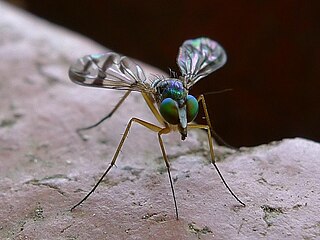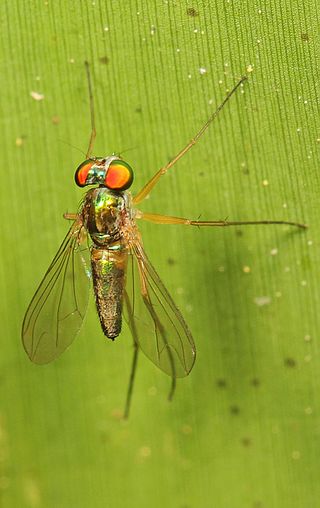
Thrypticus is a genus of long-legged flies in the family Dolichopodidae. There are about 90 described species in Thrypticus. All known larvae of the genus are phytophagous stem-miners of plants in the families Cyperaceae, Poaceae, Juncaceae, and Pontederiaceae. Female adults have a strong, pointed ovipositor used to pierce and insert eggs in the stems of the plants.
Abbemyia is a genus of flies in the family Dolichopodidae, known from Australia and New Caledonia. It is named after the French entomologist Abbé Octave Parent, who studied the family Dolichopodidae.

Austrosciapus is a genus of flies in the family Dolichopodidae. It is mainly found in Australia, though some species are also known from New Zealand, French Polynesia, Norfolk Island and the Hawaiian Islands.
Corindia is a genus of flies in the family Dolichopodidae. It is known mainly from the Afrotropical and Australasian realms, with a single species from the Palaearctic realm and an undescribed species also known from the Neotropical realm. The genus was first described in 1986 by Daniel J. Bickel, who originally considered it to be the sister group of the genus Thrypticus. Bickel later suggested that Corindia may represent a plesiomorphic and paraphlyetic assemblage from which Thrypticus arose.
Dytomyia is a genus of flies in the family Dolichopodidae. It is known from Australia, Madagascar and Kenya, with an undescribed species from Papua New Guinea.
Helixocerus is a genus of flies in the family Dolichopodidae. It is known from New Caledonia, American Samoa and Western Samoa.

Heteropsilopus is a genus of flies in the family Dolichopodidae. The genus comprises large-sized sciapodines mostly with a strongly sinuate m-cu and simple digitiform cercus. The strongly sinuate m-cu is considered to be a distinctive group autapomorphy.
Krakatauia is a genus of flies in the family Dolichopodidae.
Mesorhaga is a genus of flies in the family Dolichopodidae.
Narrabeenia is a genus of flies in the family Dolichopodidae, living in Australia and named for Narrabeen, New South Wales.

Naufraga hexachaeta is a species of fly in the family Dolichopodidae. It is the only member of the genus Naufraga, and is found only in the South Island of New Zealand.
Negrobovia is a genus of flies in the family Dolichopodidae found in Australia. It is named in honor of O.P. Negrobov.

Parentia is a large genus of flies in the family Dolichopodidae.
Pilbara octava is a species of fly in the family Dolichopodidae from Australia, and the only member of the genus Pilbara. The genus is named after the Pilbara region of Western Australia, where P. octava was found. In particular, the only known location of P. octava is at Millstream, Fortescue River.
Plagiozopelma is a genus of flies in the family Dolichopodidae.
Yumbera is a genus of flies in the family Dolichopodidae, known from eastern mainland Australia and Tasmania. The generic name is an Australian aboriginal word meaning "fly".

Sciapodinae is a subfamily of flies in the family Dolichopodidae. Members of the subfamily possess several ancestral characteristics of the family, such as branched vein M1+2 in the wings (though M2 is absent or reduced in Mesorhagini) and a pedunculate hypopygium. They also typically have a deeply excavated vertex, giving their heads the appearance of a dumbbell when viewed from the front.

Sciapodini is a tribe of flies in the family Dolichopodidae.

Chrysosomatini is a tribe of flies in the family Dolichopodidae.
Nothorhaphium is a genus of flies belonging to the family Dolichopodidae. It includes four species from Australia and a single species from New Guinea. Nothorhaphium superficially resembles the genus Rhaphium, but it belongs in the subfamily Sympycninae and is thought to be closely related to the genera Syntormon, Parasyntormon and Ceratopos. The name of the genus is derived from the Greek νόθος, and Rhaphium.






